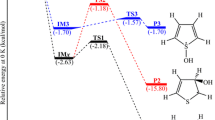Abstract
Background, Aim and Scope
The reactions between organic compounds and reactive radicals in solution define the fate of the parent molecules in the natural environment and in the processes of water and wastewater treatment. However, the reaction kinetics is known for a limited number of compounds only. For this reason, various attempts have been made to correlate chemical structure and reactivity, in order to foresee the reactivity of compounds that have not yet been tested. Many examples of this kind are reviewed in the literature, concerning reactions with various important oxidising species (·OH, CO3-·, RO·, ROO·, excited triplet states, 1O2, ClO2, H2O2, O3, CrO42-, MnO4-).
-
Recent studies underline the environmental significance of further aqueous-phase processes that can involve aromatic compounds, such as nitration and halogenation. These processes involve reactions between the substrates (e.g. phenols) and reactive radicals (·NO2, Cl2-·, Br2-·). As far as the impact of the reaction intermediates on human health and the environment is concerned, aromatic nitroderivatives are powerful direct mutagens, nitrophenols are phytotoxic, and many halogenated compounds are involved in the depletion of stratospheric ozone.
-
Among the descriptors that can be used to assess the structure-activity relationship, by far the simplest ones are the Hammett substituent constants, s and s+. One prefers s+ for interaction between an electron-donating substituent group and a developing positive charge in the transition state, as can happen during electrophilic aromatic substitution. The main drawbacks connected with the use of s and s+ are the non-general applicability to reactions initiated by free radicals, the limitation to aromatic compounds belonging to the same class, and the fact that the approach works better for meta- and para-substituted compounds than for the ortho- ones, where unaccounted effects other than field and resonance can be operational. However, the drawbacks are compensated by the very simple methodology.
-
This work will adopt the Hammett approach to predict the reactivity of various classes of aromatic compounds with the radicals Cl2-·, Br2-·, ·NO2, SO3-·, and SO4-· in aqueous solution. Materials and Methods: - Results: - Discussion: - Conclusions: - Recommendations and Perspectives: -
Similar content being viewed by others
Author information
Authors and Affiliations
Corresponding authors
Rights and permissions
About this article
Cite this article
Vione, D., Maurino, V., Minero, C. et al. An Empirical, Quantitative Approach to Predict the Reactivity of Some Substituted Aromatic Compounds Towards Reactive Radical Species (Cl2-·, Br2-·, ·NO2, SO3-·, SO4-·) in Aqueous Solution (3 pp). Env Sci Poll Res Int 13, 212–214 (2006). https://doi.org/10.1065/espr2006.06.318
Received:
Accepted:
Published:
Issue Date:
DOI: https://doi.org/10.1065/espr2006.06.318




